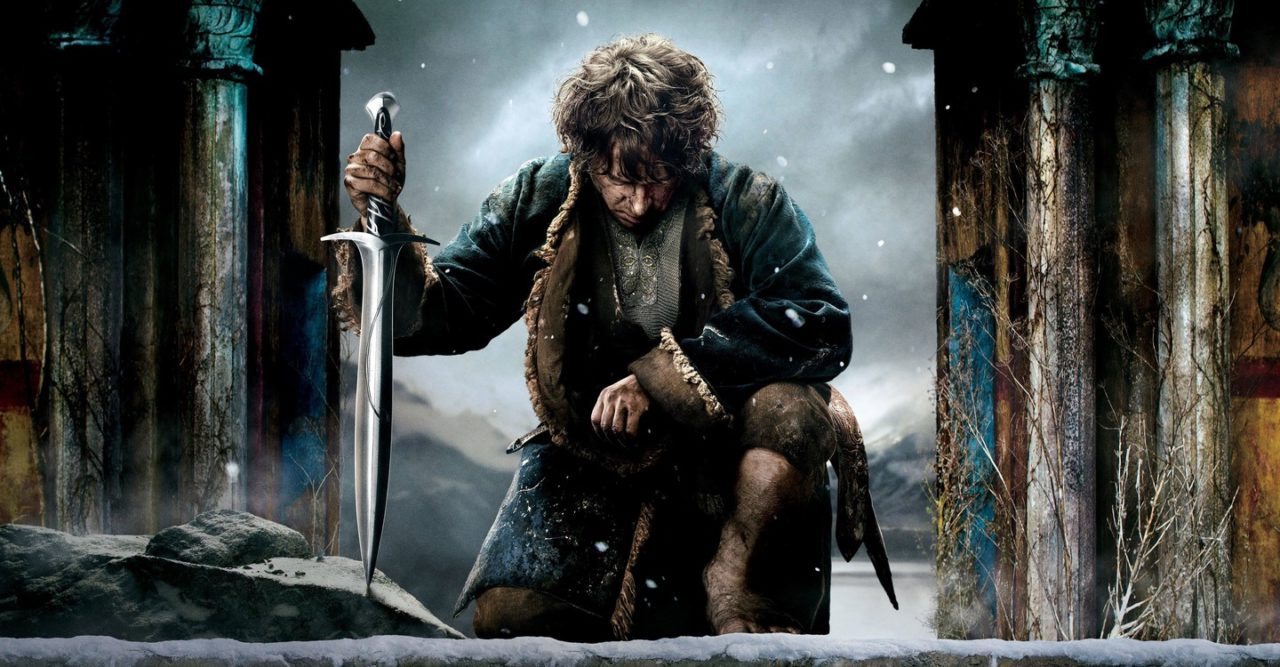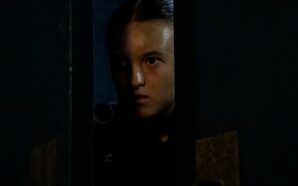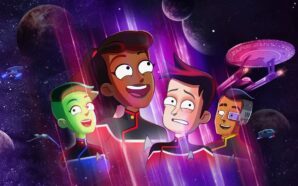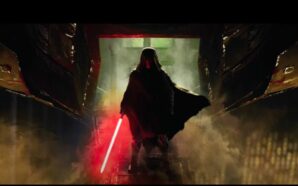For huge billion-dollar movies that serve as prequels to one of the most beloved and successful film trilogies of all time, The Hobbit films feel somewhat forgotten. I myself have left the films collecting dust on my shelf since they were first released, but this past housebound spring I spent my time watching films from my collection that I think deserve another shot. That’s not to say I didn’t enjoy The Hobbit trilogy upon release, but compared to the Lord of the Rings trilogy the later films just didn’t have the same magic to them. I remember them as baggy and messy; an unnecessarily grand adaptation of JRR Tolkien’s children’s book.
Last week I revisited the first film in the trilogy, An Unexpected Journey, and was pleasantly surprised to find to be a fun adventure film, although not without flaws. This week I’m exploring The Desolation of Smaug, a film with many more problems, but the decrease in quality from the first film proved less severe than I remembered. Again, it’s a fun adventure film, but the trilogy begins to have a serious identity crisis and a poor mixing of tones.
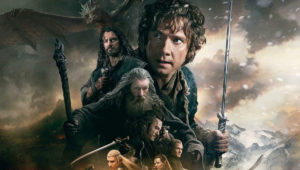 I stated last week that the extended cuts are the definitive versions of the Middle Earth films and while that may be true for The Lord of the Rings trilogy, I fear the same doesn’t apply for The Hobbit. While the extended version of An Unexpected Journey works as a sweeping epic, The Desolation of Smaug is quite the opposite. While some of the added scenes are entertaining, it’s clear they weren’t cut for brevity but rather because the film has major structural and pacing problems in its full 186-minute form. The middle instalment of trilogies can be difficult, an issue The Lord of the Rings transcended with The Two Towers – my personal favourite of the three. There is no definitive beginning or end for a middle instalment, especially the middle of a single short children’s book expanded into three epic movies. The Desolation of Smaug’s theatrical edition is undoubtedly the best version of the film.
I stated last week that the extended cuts are the definitive versions of the Middle Earth films and while that may be true for The Lord of the Rings trilogy, I fear the same doesn’t apply for The Hobbit. While the extended version of An Unexpected Journey works as a sweeping epic, The Desolation of Smaug is quite the opposite. While some of the added scenes are entertaining, it’s clear they weren’t cut for brevity but rather because the film has major structural and pacing problems in its full 186-minute form. The middle instalment of trilogies can be difficult, an issue The Lord of the Rings transcended with The Two Towers – my personal favourite of the three. There is no definitive beginning or end for a middle instalment, especially the middle of a single short children’s book expanded into three epic movies. The Desolation of Smaug’s theatrical edition is undoubtedly the best version of the film.
Most of the added/cut material is from the beginning of the film, and once The Desolation of Smaug begins in earnest it’s great. It’s just that that happens 30 minutes into the runtime. The film picks up where the previous entry ended with Bilbo, Gandalf and The Dwarves running from Azog’s Warg pack. They eventually take shelter in Beorn’s house – a skin-changer who takes the form of a bear – and hang around for far too long. First of all, Beorn looks too much like a Warg while in his bear state which makes the chase sequence fairly confusing, and secondly, I just don’t think the character needed to be included. Yeah, he gives Gandalf a little more information about Mirkwood which makes him leave the company to investigate, but it’s not worth 30 minutes. The opening, while having some cute moments, is a slog and I would have cut Beorn completely. There would be cries from fans about it but beginning at Mirkwood would be much better. Beorn should have been the Tom Bombadil of The Hobbit film trilogy.
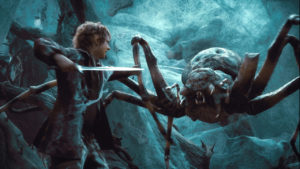 While the structure of the film’s first half is very episodic, with each chapter getting its own 15-minute adaptation (Beorn, Mirkwood, Spiders, Elves, Barrels), I think pretty much everything from when the Dwarves enter Mirkwood until they reach Lake-town is great. It continues that fun sense of adventure the first film had and strikes that delicate tonal balance. I love Bilbo’s trippy journey through the woods, his mind being messed with by either evil or magic mushrooms, maybe both, and the beautiful moment he sticks his head above the oppressive canopy to see the sun. And, despite being terrified of them in real life, there’s nothing I love more in a fantasy film than giant spiders.
While the structure of the film’s first half is very episodic, with each chapter getting its own 15-minute adaptation (Beorn, Mirkwood, Spiders, Elves, Barrels), I think pretty much everything from when the Dwarves enter Mirkwood until they reach Lake-town is great. It continues that fun sense of adventure the first film had and strikes that delicate tonal balance. I love Bilbo’s trippy journey through the woods, his mind being messed with by either evil or magic mushrooms, maybe both, and the beautiful moment he sticks his head above the oppressive canopy to see the sun. And, despite being terrified of them in real life, there’s nothing I love more in a fantasy film than giant spiders.
While it’s not the Shelob scene from Return of the King, I enjoy Bilbo and the Dwarves fighting off the arachnid swarm, particularly when the Dwarves rip the legs of a spider and its torso plops down on Bombur’s stomach. There’s a surprising number of Bombur-aimed fat jokes in the film, and just a lot of Bombur in general. He gets multiple moments to shine while several of the other Dwarfs barely appear. I forgot James Nesbitt was in the film until about 2 hours and 15 minutes in. Unlike the adaptation of the Beorn chapter, the spider scene offers us a glimpse at Bilbo’s rapidly changing character development. He starts to rely on the One Ring and, after learning when to spare a life in the previous film, his obsession with the piece of magical jewellery leads him to needlessly kill a baby spider, earning his sword the name Sting. As much as I like Bilbo and hate spiders, it’s a surprisingly disturbing and effective moment.
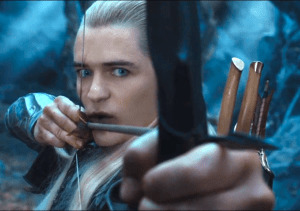 But the Dwarves and a lowly Hobbit can’t defend against a whole cluster of spiders and so in come the Elves to save them, led by Legolas. As someone born in the mid-nineties and saw the LotR films at the perfect age, I loved Legolas. Still do, in fact. I used to use sticks as Elven swords, pretend to pull arrows from an imaginary quiver behind my (very real) long blond locks, and slide on my Heelys like a Urak-Hai shield on a Helms Deep staircase. And the younger Legolas played by an older Orlando Bloom we see in The Desolation of Smaug sure likes sliding on things. Dead spiders, live Orcs and multiple rooftops: If you’ve got it, Legolas (or his CGI body double) will slide on it. This younger Legolas is clearly more arrogant than his LotR counterpart and is very much his father’s son, until he is humbled by fellow Elf Tauriel’s romance with Kili the Dwarf and is proved not to be as good a fighter as he believed he was, getting beaten by Bolg, after which we see him bleed and blink for the first and only time. Ultimately, does Legolas need to be in these films? No, but I’m quite glad he is and his appearance isn’t completely egregious.
But the Dwarves and a lowly Hobbit can’t defend against a whole cluster of spiders and so in come the Elves to save them, led by Legolas. As someone born in the mid-nineties and saw the LotR films at the perfect age, I loved Legolas. Still do, in fact. I used to use sticks as Elven swords, pretend to pull arrows from an imaginary quiver behind my (very real) long blond locks, and slide on my Heelys like a Urak-Hai shield on a Helms Deep staircase. And the younger Legolas played by an older Orlando Bloom we see in The Desolation of Smaug sure likes sliding on things. Dead spiders, live Orcs and multiple rooftops: If you’ve got it, Legolas (or his CGI body double) will slide on it. This younger Legolas is clearly more arrogant than his LotR counterpart and is very much his father’s son, until he is humbled by fellow Elf Tauriel’s romance with Kili the Dwarf and is proved not to be as good a fighter as he believed he was, getting beaten by Bolg, after which we see him bleed and blink for the first and only time. Ultimately, does Legolas need to be in these films? No, but I’m quite glad he is and his appearance isn’t completely egregious.
Legolas brings the Dwarves to his father Thranduil, and while the Elven King and potential Dwarven King Thorin have a stubbornness-off, a romance forms between Elf Tauriel and sexy non-bearded, non-facial prosthetic-ed Kili the Dwarf. And this subplot is completely egregious. There’s no reason to be wasting the running time on this out-of-place subplot. Romance was a major part of The Lord of the Rings so I can see why Peter Jackson and the writers would want to include some in The Hobbit, but the subplot never justifies its existence. I would much rather spend time further examining the political rift between Thranduil and the Dwarves, and the Elf’s reluctance to help them unless he gets his share of the treasure hoard. The scene we do get between Thorin and Thranduil is great but I’d have loved to see more.
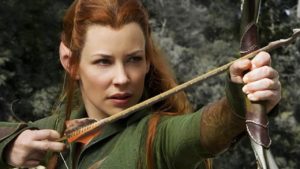 I can see the thematic underpinning of the romance storyline as a classic Romeo and Juliet rip-off, where these two races are at odds but a member of each fall in love while their leaders fight, with Legolas creating the third point in a love triangle, but it just doesn’t need to be in the film. It’s made worse by the fact it starts with a cringey dick joke by Kili which should do the exact opposite of woo a member of the high and mighty Elven species. Tauriel seems to act out of character for an Elf by responding to Kili’s nonsense and Kili just doesn’t look like a Dwarf. Well, until they cut to a wide shot during the romantic conversation which ruins the sexual tension because the height difference in hilarious. Throughout the ‘falling in love’ scene I was thinking of nothing but, “get to the barrel sequence already!”
I can see the thematic underpinning of the romance storyline as a classic Romeo and Juliet rip-off, where these two races are at odds but a member of each fall in love while their leaders fight, with Legolas creating the third point in a love triangle, but it just doesn’t need to be in the film. It’s made worse by the fact it starts with a cringey dick joke by Kili which should do the exact opposite of woo a member of the high and mighty Elven species. Tauriel seems to act out of character for an Elf by responding to Kili’s nonsense and Kili just doesn’t look like a Dwarf. Well, until they cut to a wide shot during the romantic conversation which ruins the sexual tension because the height difference in hilarious. Throughout the ‘falling in love’ scene I was thinking of nothing but, “get to the barrel sequence already!”
There’s no sequence more fun in The Hobbit trilogy than the barrel escape. After using the One Ring to free the Dwarves from Elven capture, Bilbo and the company flee in barrels down the river, only to be hunted by Elves and Orcs alike. It’s such an entertaining and unique action set piece, with a good mix of practical effects and CGI. Some of the visual effects aren’t the best but for whatever reason it never bothers me in that scene. Maybe because it’s not trying to be serious, but rather has fun with the concept without being too silly. The scene has a great pace to it after about an hour of slower storytelling and seeing the Dwarves work together to evade capture or death while the two races hunting them fight each other is great fun. The only thing I don’t like is that there are some GoPro camera shots early in the sequence which stick out like a sore thumb. They just don’t fit with the fantasy epic vibe. Those shots were bad at the time and have aged very poorly.
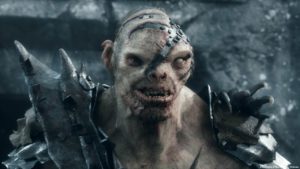 Remember Azog from An Unexpected Journey? Well, the Pale Orc decides to abandon his quest for vengeance and return to his master Sauron, leaving Bolg to hunt the Dwarves. I think this is a terrible decision because the entire first film set up Azog as Thorin’s nemesis and now it’s Bolg, a big boring CGI Orc with a lack of personality and a forgetful design, who is seeking the Dwarves. Why not swap roles and have Bolg be the one at Dol Guldor and Azog continue the hunt? I’m baffled by this decision but don’t have to be for long because as Desolation enters its second half, the film switches from the cat-and-mouse chase movie to settling at a more permanent location just below the Lonely Mountain: Lake-town.
Remember Azog from An Unexpected Journey? Well, the Pale Orc decides to abandon his quest for vengeance and return to his master Sauron, leaving Bolg to hunt the Dwarves. I think this is a terrible decision because the entire first film set up Azog as Thorin’s nemesis and now it’s Bolg, a big boring CGI Orc with a lack of personality and a forgetful design, who is seeking the Dwarves. Why not swap roles and have Bolg be the one at Dol Guldor and Azog continue the hunt? I’m baffled by this decision but don’t have to be for long because as Desolation enters its second half, the film switches from the cat-and-mouse chase movie to settling at a more permanent location just below the Lonely Mountain: Lake-town.
After seeing so many familiar Middle Earth locations in the first film, it’s wonderful to see a completely new setting in this fantasy world. The design of Lake-town is truly fantastic and at once feels unique and fresh while also clearly is a part of the same world we are used to. Howard Shore’s Lake-town theme is also very good and one of the most memorable of the trilogy. It’s at Lake-town however where the film drastically changes and that fun sense of adventure which I want from an adaptation of The Hobbit, and was my favourite aspect of An Unexpected Journey, comes to an end. While Erebor is still a little further away, the journey is pretty much over and the pieces have to be put in place for the upcoming conflicts with Smaug and the titular five armies of the third film. This change isn’t completely bad, in fact some of it is quite good, but I feel that the time we spend at Lake-town is stretched out and a little dull – at least in the Extended Edition. And Bilbo disappears from the film, or at least the plot, for far too long in the middle hour.
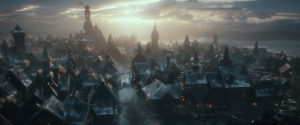 At Lake-town we’re granted an audience with a new batch of characters including the Master, Alfrid and Bard the bowman. Stephen Fry as the Master of Lake-town is certainly having fun playing the cartoony and deviously corrupt ruler. While his scenes, whether forming evil plans or eating bollocks, are enjoyable, they are also tonally at odds with the much darker feel of the second half of the film. Alfrid, who is very much the Dwight Schrute to the Master’s Michael Scott, is also a little too silly. And I know that makes me sound like a hypocrite because I’ve been wanting a lighter tone for this trilogy from the start, but this is often the wrong kind of silly. Although, from what I remember from The Battle of the Five Armies, Alfrid gets a whole lot worse. Bard is also a major character introduced but I don’t have too much to say about him. He’s…fine. A stoic character who helps the Dwarves even though he is against their plan because he fears Smaug will be unleashed on the town, leaving him as the last defense. He turns out to be right of course, as the Dwarves sail to Erebor to reclaim their homeland and unwittingly release fire and death personified (or dragonified).
At Lake-town we’re granted an audience with a new batch of characters including the Master, Alfrid and Bard the bowman. Stephen Fry as the Master of Lake-town is certainly having fun playing the cartoony and deviously corrupt ruler. While his scenes, whether forming evil plans or eating bollocks, are enjoyable, they are also tonally at odds with the much darker feel of the second half of the film. Alfrid, who is very much the Dwight Schrute to the Master’s Michael Scott, is also a little too silly. And I know that makes me sound like a hypocrite because I’ve been wanting a lighter tone for this trilogy from the start, but this is often the wrong kind of silly. Although, from what I remember from The Battle of the Five Armies, Alfrid gets a whole lot worse. Bard is also a major character introduced but I don’t have too much to say about him. He’s…fine. A stoic character who helps the Dwarves even though he is against their plan because he fears Smaug will be unleashed on the town, leaving him as the last defense. He turns out to be right of course, as the Dwarves sail to Erebor to reclaim their homeland and unwittingly release fire and death personified (or dragonified).
But as we finally get to the moment where the Dwarves are reaching Erebor, the film cuts back to Gandalf who’s on his own quest, seeking to identify the darkness emanating from Dol Guldor. But first he and Radagast journey to the High Fells of Rhudaur for a totally pointless scene. There they witness that the Witch King’s tomb, as well as those of the other eight Ring Wraiths, are empty. But both the audience and the characters already knew this would be the case. We saw the risen spirit of the Witch King in the first film and Radagast took its Morgul blade to show to Gandalf. We don’t need to see them both travel to his tomb and be surprised that he’s not there. We all knew he wouldn’t be! The subplot is so repetitive and gives us the same information multiple times. And then when Gandalf finally reaches Dol Guldor, it’s played as a huge moment that the mysterious Necromancer is actually Sauron. We didn’t need two 3-hour movies to get to this reveal. It was obvious to both the audience and Gandalf from the start.
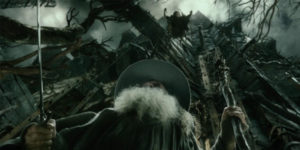 At Dol Guldor, Gandalf briefly unites with Thrain, Thorin’s father. Thrain’s initial hunting of Gandalf is actually a pretty effective horror sequence and it’s cool to see Peter Jackson return to his previous roots as a horror director. But not everything with Thrain is so good. We get some surprisingly cliché dialogue between the characters, with Thrain’s “Tell my son I loved him” being combated by Gandalf’s “Tell him yourself”. And then, of course, Thrain dies and lets out a Wilhelm scream while doing so for good measure. I enjoy that famous sound effect but it is very out of place in that dramatic moment. Thrain also opens the door to some failings in the logic of the plot. He states that “The Dragon and The One are already in league”, but how? Sauron kept Thrain alive to learn where the map and key to Erebor was but why would Sauron need such things if he was already in league, and therefore communicating, with Smaug?
At Dol Guldor, Gandalf briefly unites with Thrain, Thorin’s father. Thrain’s initial hunting of Gandalf is actually a pretty effective horror sequence and it’s cool to see Peter Jackson return to his previous roots as a horror director. But not everything with Thrain is so good. We get some surprisingly cliché dialogue between the characters, with Thrain’s “Tell my son I loved him” being combated by Gandalf’s “Tell him yourself”. And then, of course, Thrain dies and lets out a Wilhelm scream while doing so for good measure. I enjoy that famous sound effect but it is very out of place in that dramatic moment. Thrain also opens the door to some failings in the logic of the plot. He states that “The Dragon and The One are already in league”, but how? Sauron kept Thrain alive to learn where the map and key to Erebor was but why would Sauron need such things if he was already in league, and therefore communicating, with Smaug?
This all points to the unnecessary prequelisation of The Hobbit. Instead of being its own trilogy, it’s setup for The Lord of the Rings. Why does Smaug have to be in league with Sauron? We learn that Gandalf pushed Thorin to go on the quest in order to get Smaug off the table when war comes, and that Sauron is behind Azog. All the characters are just chess pieces for a precursor game that we’ll see play out in the next trilogy. I know some of this information might be from the appendices of Return of the King, but I don’t want these films to just feel like ancillary material to another trilogy. Simply some extra information for the main event in The Lord of the Rings. I want that fun adventure film of Dwarves reclaiming their treasure. And that’s in there somewhere, just with a lot of unnecessary baggage piled on top.
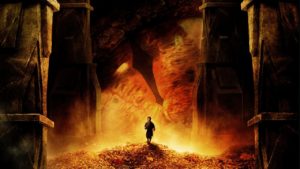 But once Gandalf is captured by Sauron, we cut back to Bilbo and the Dwarves on the Lonely Mountain, searching for the entrance to Erebor. I enjoy this scene quite a lot, even if it is clearly a lesser version of the Fellowship trying to open the door to Moria. Bilbo is the one to discover the secret that opens the door, which continues his arc from reluctant adventurer to the character most invested in the mission’s success. After some stern words from Thorin that imply Dragon’s sickness taking hold, Bilbo is sent into Smaug’s lair to search for the Arkenstone. And what a dark lair it is. I know I’ve complained about the tone of the films being too dark but the last hour of Desolation is just literally too dark. The treasure room is described as “chambers filled with golden light” and yet it’s gloomy. The gold should be bright and sparkling but instead, from afar, looks like mounds of dirt rather than treasure.
But once Gandalf is captured by Sauron, we cut back to Bilbo and the Dwarves on the Lonely Mountain, searching for the entrance to Erebor. I enjoy this scene quite a lot, even if it is clearly a lesser version of the Fellowship trying to open the door to Moria. Bilbo is the one to discover the secret that opens the door, which continues his arc from reluctant adventurer to the character most invested in the mission’s success. After some stern words from Thorin that imply Dragon’s sickness taking hold, Bilbo is sent into Smaug’s lair to search for the Arkenstone. And what a dark lair it is. I know I’ve complained about the tone of the films being too dark but the last hour of Desolation is just literally too dark. The treasure room is described as “chambers filled with golden light” and yet it’s gloomy. The gold should be bright and sparkling but instead, from afar, looks like mounds of dirt rather than treasure.
Out of those mounds of dirt – err, I mean gold – comes the dragon Smaug who is awakened by Bilbo’s hairy Hobbit feet pattering on his claimed treasure. I guess there were no consequences to the ending of the last film where Smaug is awoken by a Thrush because he’s fast asleep again by the time Bilbo arrives. But regardless, Smaug is an incredible mixture of computer graphics and fearless performance. As I said in my revisit of An Unexpected Journey, the trilogy’s best scenes feature Bilbo in a battle of wits against some mythical creature. The tête-à-tête with Smaug may not be as good as Gollum’s ‘Riddles in the Dark’ sequence but it’s pretty damn close. Just Smaug talking, the thunder of his voice rather than his wings, is captivating. In a trilogy of wonky CGI, Smaug looks amazing and Benedict Cumberbatch’s voice is perfectly deep. Smaug is by far the greatest dragon in film or television. Yes, even better than Sean Connery in Dragonheart.
 The awkward pacing and structure of the film then makes a dramatic return as the movie struggles to decide how to end. To create an action-filled finale where there is none, we return to Lake-town where a handful of Dwarves have stayed behind with Legolas and Tauriel, with further inane romance between a mortally injured Kili and his Elven love interest. Bolg launches an attack and has to be driven from the town in a parkour-filled scene of Legolas clumsily fighting CGI monstrosities. And instead of flying off to Lake-town to burn to floating wooden settlement to ash, Smaug faces off against the Dwarves in Erebor’s forge. There are some fun moments in the fight – such as Thorin standing on the tip of Smaug’s snout – but the sequence is ultimately a mess. I just watched it yesterday and already I’m forgetting it. It’s simply Dwarves running from a dragon, randomly pulling levers to melt gold before the molten metal bursts onto Smaug’s scales in an unsuccessful attack. You can tell it was cobbled together to give the film a sense of an ending without actually giving us one.
The awkward pacing and structure of the film then makes a dramatic return as the movie struggles to decide how to end. To create an action-filled finale where there is none, we return to Lake-town where a handful of Dwarves have stayed behind with Legolas and Tauriel, with further inane romance between a mortally injured Kili and his Elven love interest. Bolg launches an attack and has to be driven from the town in a parkour-filled scene of Legolas clumsily fighting CGI monstrosities. And instead of flying off to Lake-town to burn to floating wooden settlement to ash, Smaug faces off against the Dwarves in Erebor’s forge. There are some fun moments in the fight – such as Thorin standing on the tip of Smaug’s snout – but the sequence is ultimately a mess. I just watched it yesterday and already I’m forgetting it. It’s simply Dwarves running from a dragon, randomly pulling levers to melt gold before the molten metal bursts onto Smaug’s scales in an unsuccessful attack. You can tell it was cobbled together to give the film a sense of an ending without actually giving us one.
The ending we do get is a cliffhanger, complete with a dramatic cut-to-black, of Smaug shedding his golden coat and heading towards Lake-town, stating “I am fire. I am Death”. It’s quite a good tease to get you back in the cinema for round three but is a little unfulfilling. The choice to cut the adaptation into three damaged both the beginning and ending of the middle film, but I can see no other choice than to end Desolation in this way. If the Lake-town battle (which I’m anxious to see again because I have no memory of it) had been at the end of this film then there’d have to be some other dramatic moment to end on. If not then we end the second film in the trilogy with the quest for Erebor complete: The Dwarves rule the mountain and Smaug is dead. Huge battle to come or not, it would feel like an ending of the whole story and people wouldn’t want to return to see the third part where a new conflict is created.
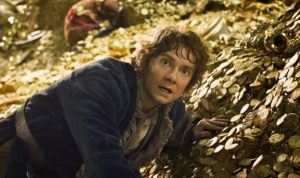 Ultimately, the drop-off in quality between the first and second films of The Hobbit trilogy was not as drastic as I once thought. I enjoyed revisiting The Desolation of Smaug much more than I thought I would, and while I still prefer An Unexpected Journey, because of the lighter tone and general sense of adventure, there are certainly moments which hit similar highs. But there are lower lows too. The LotR prequel elements dominate too much of the plot and the Gandalf and Tauriel subplots are tedious. And this might be the only Middle Earth film where the theatrical cut is better than the extended cut; there are pacing problems aplenty. The tone becomes darker than what I want from an adaptation of The Hobbit by the film’s end and points to the upcoming disappointment of The Battle of the Five Armies. But maybe I’ll be pleasantly surprised again and find there’s more to like in the final chapter of the trilogy than I remember. Somehow, I doubt it.
Ultimately, the drop-off in quality between the first and second films of The Hobbit trilogy was not as drastic as I once thought. I enjoyed revisiting The Desolation of Smaug much more than I thought I would, and while I still prefer An Unexpected Journey, because of the lighter tone and general sense of adventure, there are certainly moments which hit similar highs. But there are lower lows too. The LotR prequel elements dominate too much of the plot and the Gandalf and Tauriel subplots are tedious. And this might be the only Middle Earth film where the theatrical cut is better than the extended cut; there are pacing problems aplenty. The tone becomes darker than what I want from an adaptation of The Hobbit by the film’s end and points to the upcoming disappointment of The Battle of the Five Armies. But maybe I’ll be pleasantly surprised again and find there’s more to like in the final chapter of the trilogy than I remember. Somehow, I doubt it.
What do you think about The Desolation of Smaug? How do you rank The Hobbit trilogy? Let me know in the comments and be sure to geek out with me about TV, movies and video-games on Twitter @kylebrrtt.




